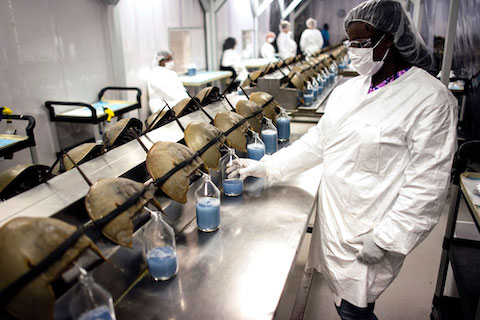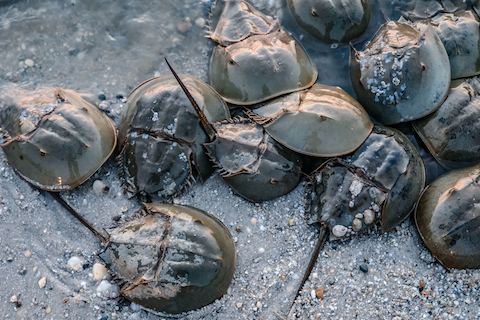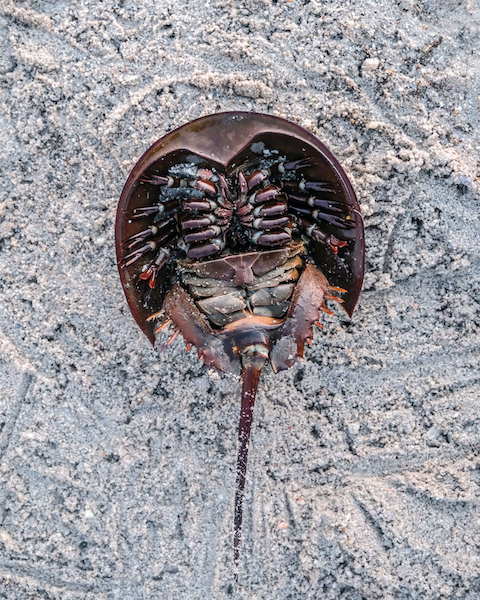
Credit: Timothy Fadek/Corbis/Getty
In another episode, we talked about the horseshoe crab, which has existed on Earth nearly unchanged for more than 400 million years. In the last 40 years, it’s become a vital player in our medical industry.
Why? It’s in their blood.
Horseshoe crab blood is copper based, not iron based like ours, which makes it blue.
It coagulates so rapidly and completely around invading pathogens, that medical researchers realized it could be used to detect pathogens for us too.
So they isolated the coagulating agent, called LAL, powdered it, and now use it to test every vaccine, intravenous drug, and medical implant for the presence of bacteria in every hospital and lab around the world today.
To get enough blood to produce the LAL, medical companies capture half a million horseshoe crabs each year when the creatures congregate for spawning. They drain about 30% of their blood and then release them.
This procedure, along with human beach encroachment and increased fishing pressure, is reducing horseshoe crab numbers worldwide.
Scientists have responded by creating a synthetic substance similar to LAL, which is starting to replace the original, and with breeding programs to rebuild populations.
If you ever find a horseshoe crab on a beach, you can lend a hand. Pick it up by its shell—never by its tail, which can harm it—put it back in the water, and thank it for its service to humans.
Background
Synopsis: The primitive immune systems of horseshoe crabs have effectively protected them through the eons, and a unique extract derived from their blue blood also protects humans from potentially fatal toxins. That substance is essential for the testing of any medical material that comes in contact with our bloodstream, including vaccines, IVs, and implants.
- In an earlier episode of EarthDate, we briefly covered the primitive immune systems of horseshoe crabs and how they protect the body from harmful bacteria and toxins.
- Blood-like hemolymph contains granular amebocyte cells, which cause the blood to gel quickly when exposed to certain bacteria and toxins. This key clotting agent is called Limulus amebocyte lysate (LAL), and it’s only found in the blood of horseshoe crabs.
- The same gram-negative bacteria and endotoxins that cause horseshoe crab blood to coagulate are extremely toxic to humans. These substances are also very difficult to detect in less than 2 days—unless you have a horseshoe crab handy.
- This property makes horseshoe crab blood extraordinarily important to human health. If you have ever received surgery, an intravenous drug, an injection, or a vaccination, thank Limulus for ensuring it didn’t kill you.
- Since 1977, the U.S. FDA has required LAL to be used to test for contamination in any injected, ingested, or implanted pharmaceutical product or medical device.
- Testing with LAL takes about 45 minutes. Before its use, thousands of rabbits had to suffer 48-hour tests, and laboratories had to wait.
- For decades, every pharmaceutical company in the world has relied on the blood of horseshoe crabs. About 500,000 horseshoe crabs are captured annually to fulfill the demand for the clotting agent in their blood.
- Captured horseshoe crabs have up to 30% of their milky blue blood harvested via their large dorsal pericardium blood sinus. This must be done in a sterile lab to avoid clotting.
- After harvesting, the extract is separated from the blood into the concentrate called LAL. LAL costs about $60,000 per gallon to produce because the process is so time-consuming.
- The LAL is further concentrated into a white powder that will cause a sample to gel within 45 minutes in the presence of toxins.
- Demand for LAL will only increase as vaccines for COVID-19 undergo development and require testing.
- To produce 5 billion safe vaccine doses, 600,000 tests will be performed, requiring just one day’s production of the lysate.
- During high tides, especially during the new moon or full moon, horseshoe crabs gather in large masses to spawn on beaches along the North Atlantic and Gulf of Mexico coasts, and in Southeast Asia.
- Their shells clack together loudly as they search among the crowd for mates before finally making their way in pairs to burrows, where the female lays a few thousand eggs and the male fertilizes them. Afterward, they head back into the sea.
- In about 2 weeks, the eggs hatch, and the hatchlings take 3 years to grow just an inch long (2.5 cm). The animals molt often as they mature, growing a larger shell each time.
- These spawning episodes make horseshoe crabs vulnerable to capture as they collect along shorelines en masse.

Credit: Alex Wroblewski
- Despite hundreds of millions of years of survival through all Earth’s great extinctions, Earth’s population of these hearty creatures is steadily declining in the face of the most aggressive predator the horseshoe crab has ever faced: humans.
- Coastal construction is destroying the habitats of these creatures.
- Both their eggs and their meat are considered to be delicacies in Asia.
- In the United States, they have been overharvested for use as fertilizer and as fodder for eels and whelks in marine fisheries.
- And they are threatened by the bleeding process they undergo to provide LAL for the pharmaceutical and medical equipment industries.
- After the horseshoe crabs are bled, they can be released back to the sea. Unfortunately, up to 30% of them die because they are mishandled, too much of their blood is extracted, or their gills are out of water for more than 4 days.
- But there is some good news for horseshoe crabs.
- Researchers have developed a process to create a substance called recombinant factor C (rFC), which is a synthetic substitute for LAL.
- European regulators and some pharmaceutical companies are now accepting the use of synthetic rFC for testing vaccines in lieu of LAL.
- However, in July 2020, the United States Pharmacopeia chose not to give the synthetic version equal standing to the clotting agent made from horseshoe crab blood, citing unproven safety concerns despite encouragement from the U.S. Senate.

Credit: Charles River LAL Testing
- Horseshoe crabs are essential as a modern keystone species in ecosystems like the Delaware and Chesapeake Bays, where they support the whole food web.
- Their protein-rich eggs are vital to sport fish, vulnerable turtles, and shorebirds.
- Some endangered migratory birds, like the red knot, time their migration to coincide with Limulus spawning events, doubling their weight on a 2-week stopover for these eggs in Delaware Bay during their amazing 9000 mile (14,500 km) annual trip from the southern tip of Chile to their Arctic breeding grounds.
- The crab count in Delaware Bay has dropped from 1.2 million in 1990 to just 335,000 in 2019.
- Recently, pharmaceutical companies have started conservation programs, raising and releasing about 100,000 juvenile horseshoe crabs into the Atlantic near Massachusetts and Rhode Island in 2019.
- If you find a live horseshoe crab on the beach, take the time to look at it. These amazing creatures don’t sting and won’t hurt you.
- About 10% of horseshoe crabs die each year because they are unable to right themselves when they flip over. If you find an upside-down horseshoe crab, you can help by using their shell to flip them over.
- Handle it only by the edges of the rounded carapace to avoid injuring it.
- Don’t touch the tail—it is covered with photoreceptors that help the animal to navigate and can be injured easily.
